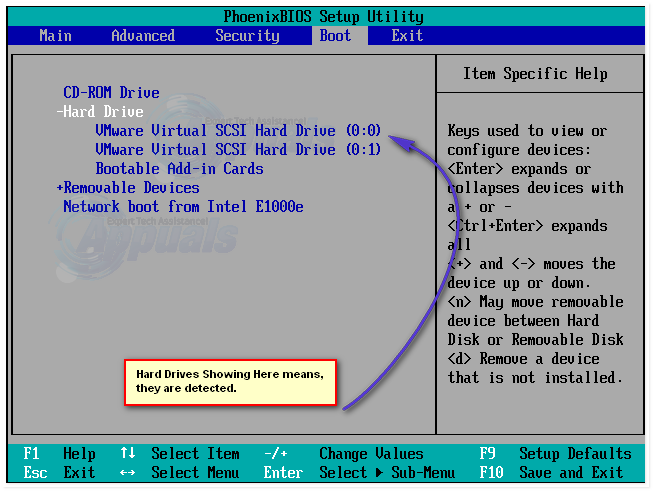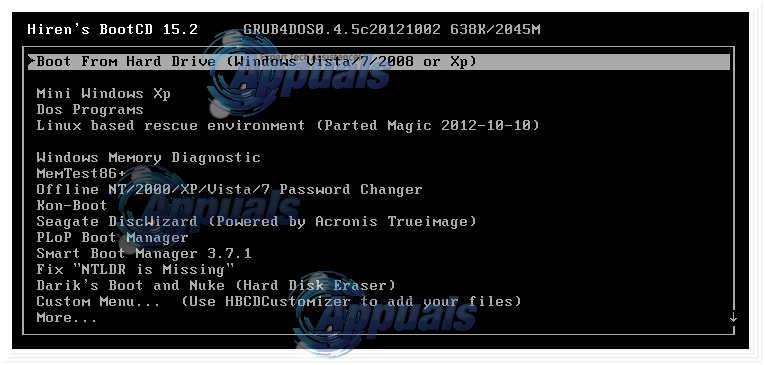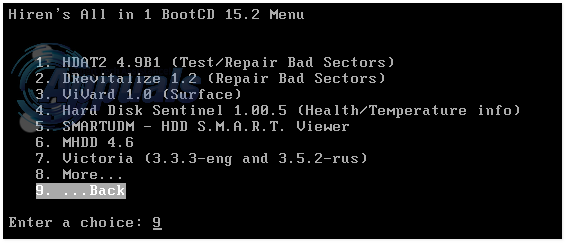However, a failed or failing Hard Disk Drive is not the only thing that can keep a computer from booting into its Operating System as it should. Also, getting a replacement for a failed or failing HDD can cost a substantially large amount of money. This is why you need to be sure that your HDD has failed or is failing before you attempt to repair the problem or replace the HDD. The following are the two most effective methods that you can use to check if your HDD has failed or is failing:
Method 1: Check to see if the drive is visible in BIOS settings
The simplest method that you can use to determine whether or not your Hard Disk Drive has failed or is failing is to see whether or not the drive shows up in your computer’s BIOs settings. However, while this test may be simple and straightforward, be warned as it is not entirely conclusive and that you will most likely also have to use Method 2 to be sure of your HDD’s status. Restart the computer. Enter your computer’s BIOS (or UEFI) settings as soon as it starts up. The key that you need to press to enter these settings depends on the manufacturer of your computer’s motherboard and can be anything from Esc, Delete or F2 to F8, F10 or F12. The key is almost always displayed on the first screen you see when you boot your computer up and is also listed in the manual that was supplied with your system. In addition, a quick Google search asking “how to enter bios on” followed by the model number or manufacturer of your computer’s motherboard will also tell you what key you need to press. Find an option named Boot order or something similar. This option is mostly located under the Boot tab but you may have to peruse through the different tabs in your BIOS settings to locate it. Check if your Hard Disk Drive is listed in your computer’s boot order.
If the HDD is listed in your computer’s boot order but your computer still fails to boot into its Operating System, it would be best if you move onto Method 2 to determine the exact status of your HDD. It your HDD is nowhere to be found in the computer’s boot order, attempt to modify the boot order and see if the HDD is listed in the available options. If the HDD is not even listed as an available option when you choose to modify your computer’s boot order, there is a pretty decent chance that it has already failed or is failing. Even though that is the case, it is recommended that you move onto Method 2 and run diagnostics on your HDD just to be sure that it is, in fact, faulty.
Method 2: Run diagnostics on the hard drive
If your HDD is not visible in your computer’s BIOS settings or if it is visible but fails to boot into the Operating System, there is a pretty good chance that it has already failed or is failing. However, if you want to be sure of your Hard Disk Drive’s status, you will have to run diagnostics on it. Running hard drive diagnostics basically involves running a horde of different tests on an HDD to determine whether or not it is fit for duty and whether or not it has failed or is failing. There are hundreds of HDD diagnostics utilities out there, but since you can’t boot into your Operating System, your options are decreased by around 80%. This is where Hiren’s BootCD comes in. Hiren’s BootCD is a bootable utility that has tons of freeware utilities and tools packed into one ISO file. The utilities we’re interested in is the long list of HDD diagnostics and testing utilities that Hiren’s BootCD has within its more than impressive arsenal. If you want to run diagnostics on your hard drive while your computer fails to boot into its Operating System, you will definitely be able to do so using Hiren’s BootCD. Before you can actually boot into the Hiren’s BootCD interface and start running diagnostics on your computer’s HDD, you will actually have to burn an ISO file of Hiren’s BootCD to a bootable media. To do so, you will need to get your hands on a working Windows computer, download an ISO file for Hiren’s BootCD from here and then burn it to a CD, DVD or USB drive using this guide. Once you have created a bootable medium that contains the Hiren’s BootCD interface, you need to insert it into the computer that has the HDD you want to run diagnostics on, restart the computer and boot it from the Hiren’s BootCD CD, DVD or USB that you created. In order to be able to do so, you may have to go into your computer’s BIOS settings again, but this time, instead of simply checking on your computer’s boot order you are going to have to change it to boot from your DVD/CD drive (if you created a Hiren’s BootCD CD or DVD) or a certain USB port (if you created a Hiren’s BootCD USB drive). After doing so, save your settings, exit the BIOS settings and, if prompted to do so, press any key to boot your computer from the Hiren’s BootCD bootable media. Once your computer has gotten into the Hiren’s BootCD interface, all of the tools and utilities included in the Hiren’s BootCD package will be at your disposal and you can use them to run tests and diagnostics on your HDD. You can use the tests and diagnostics you run on your HDD to determine whether or not it has failed or is failing.
Some of the best HDD testing and diagnostics utilities that are included in the Hiren’s BootCD package and are also capable of running diagnostics on HDDs of any and all brands include HDDScan, ExcelStor’s ESTest, MHDD, Victoria and ViVard. However, if you would like to determine whether or not your HDD has failed or is failing using a tool designed specifically to test HDDs of the same brand as yours, the Hiren’s BootCD package also includes the latest versions of the HDD testing and diagnostics tools designed by Western Digital, Fujitsu, Samsung, Maxtor, Quantum, SeaGate and IBM for their Hard Disk Drives. To run this test, choose Dos Tools, and then Hard Disk Tools which is the option 6.
From here, we recommend running MHDD 4.6 which can also do a mechanical check or SmartUDM 2.00. If your drives support SMART, then you should be able to read their state from either of these programs.
How to Fix No Boot Disk Has Been Detected or the Disk Has FailedFix: The Disk Check Could not be Performed Because Windows Cannot Access the…How to Free Up Hard Disk Storage on MacOS and Mac OS XFix: New Hard Drive not showing up in Disk Management


